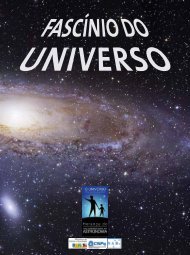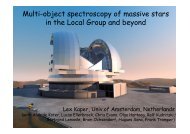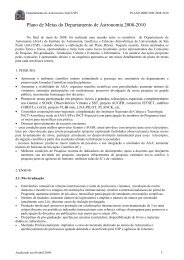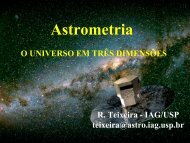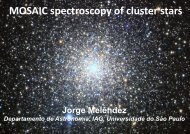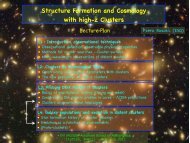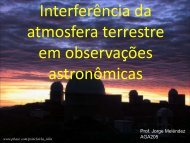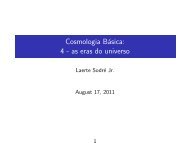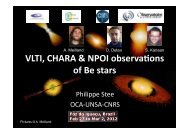Os elementos químicos
do Big Bang aos planetas rochosos - Astronomia - USP
do Big Bang aos planetas rochosos - Astronomia - USP
- No tags were found...
Create successful ePaper yourself
Turn your PDF publications into a flip-book with our unique Google optimized e-Paper software.
<strong>Os</strong> <strong>elementos</strong> <strong>químicos</strong> :do Big Bang aos planetas rochososThe chemical elements :from the Big Bang to terrestrial planetsCFBeOSJorge MeléndezDepartamento de Astronomia do IAG/USP
First elements in the universe:H, He, Li
timeEvolution of our universeFirst few minutes: H, He, Li13,7 billion yearsBig Bang
The abundances ofthe light elements(H, He, Li) formed afew minutes afterthe Big Bangdepend only on η 10(baryon-to-photon ratio)η 10 credits: NASA
timeEvolution of our universeCosmic Background Radiation13,7 billion yearsBig Bang
Cosmic Background RadiationT = 2.725 ± 0.001 KWMAPsatellitesmall fluctuations in thecosmic radiation η 10credits: NASA
The abundances ofthe light elements(H, He, Li) formed afew minutes afterthe Big Bangdepend only on η 10(baryon-to-photon ratio)η 10 credits: NASA
Cosmic Microwave BackgroundWMAP B h 2 = 0.02273±0.00062η 10 = 6.226 0.170credits: http://map.gsfc.nasa.gov(Dunkley et al. 2009)Predicted primordial lithium abundance:A(Li) = 2.72 dex Li/H = 5.2 10 -10(Cyburt et al. 2008, see also Steigman 2009; Coc & Vangioni 2010)8
Relative fluxTo test Big Bang Nucleosynthesis we needto look back in time: metal-poor starsSun: [Fe/H] = 0solar metallicityCD-38 245: [Fe/H] = - 4 (10 -4 solar)HE 0107-5240: [Fe/H] = - 5.3Population III: [Fe/H] = - ∞Wavelengthcredits: N. Christlieb9
Relative FluxPrimordial Li in metal-poor stars !Spite & Spite (1982)WavelengthAsplund et al. (2006)
WMAP+ BBN(Li = 2.72)Cosmological lithium problem2.7WMAP+ BBNStars(Li = 2.0 – 2.25)0.7 dex (factorof 5) discrepancyat the lowestmetallicitiesbetweenBBN+WMAPand starsLITHIUM in STARS:Triangles: Asplund et al 2006Squares: Bonifacio et al. 2007Filled Circles: Aoki et al. 200911 (2009) al. Aoki et
The cosmological Li problem:Li in stars is much lower (x 5) thanthe primordial Li predicted by BBNT eff scaleErrors in nuclear reaction ratesNew physics / cosmology ?Li depletion in stars ?12
Ultra high precision analysisof lithium in metal-poor starsHawaii, after observing run ...
Ultra high precision analysis oflithium in metal-poor stars usingKeck and VLT dataStellar spectrum observed with Keck (exposure time of 5 hours)Asplund & Melendez (2008)
Next steps in solving the Li problem@ IAG/USP‣ Finish data reduction‣ Accurate + precise stellar parameters‣ Determination of Li and Be abundances‣ Study of Li and Be depletion‣ Li isotopes15
Solving the cosmological Li problemTeam :‣ Jorge Melendez (IAG)‣ Martin Asplund (Australia)‣ Luca Casagrande (Australia)‣ Ivan Ramirez (Carnegie, USA)HelpWelcome !16
Periodic Table of the Astronomers ..From H and He to “metals”METALS
Chemical evolution of the elementsFrom H and He to “metals”
The first stars and the formation ofmetals (elementsheavier than H & He)PrimordialcloudsH, HeSupernova: metal-rich ejecta
Stellar EvolutionType IIsupernovaOPlanetary nebulaFeType Ia supernova(artist’s concept)
Interstellar mediumGalactic chemical evolutionH, HestarsMetal-richejecta
After 12 billion years of chemical evolution inour Galaxy, stars have produced only 2% of“metals”, the rest (98%) being H & HeThe Milky WayOur solar system
Galactic archaeologyOLD POPULATIONS
[a-elements/Fe]Galactic archaeology: disk(s)Thick disk (old disk)Thin disk (young disk)
[a-elements/Fe]Galactic archaeology: bulgeThick disk ~ Bulge
Galactic archaeology: halo(s)from dSphgalaxies ?“true” halostars?BulgeNissen &Schuster 2010
High precision chemicalabundances in metal-poor stars@ IAG / USPHigh resolution (R = 100, 000) high S/N spectra (300-1000)available to perform the highest precision study to dateHELPWELCOME !
Looking for planetarysystems like our ownSunset in Paracas, Peru(c) www.flickr.com/photos/rodrigocampos/
C. Carreau / ESAMore than 500 planetary systemsfound until nowBut ... most ofthem DO NOTresemble our ownsolar system
Most planetary systems found so far have innergiant planets, unlike the inner rocky planets ofour solar system
How to find a planetary system similarto our own?Credits: Nasa
1. Search for stars similar to our SunSol = 1 pixelBetelgeuse AntaresRigelAldebaranSiriusSolPolluxArcturus
2. In the same evolutionary stage asour Sun
3. Chemical composition ~ solar?
But there are myriad stars in the sky… how can we find solar twins?
Magnitude absolutaDiagrama H-RSOLM v = 4.82B-V ~ 0.65Indice de cor
Procura por gêmeas solares usandoo catálogo Hipparcos (+ Tycho)•Cores B T -V T•Magnitudeabsoluta V T• Outras cores (optico einfravermelho),indicadores de idade
• Nos primeiros 25anos de pesquisanão foi encontradanenhuma gêmeasolar (Cayrel deStrobel et al. 1996)
First solar twin discovered only in1997: 18 Sco18 Sco
Searching for solar twins• Programa observacional desde 2005- Keck (Havaí, USA)- McDonald (Texas, USA)- Magellan (Chile)- VLT/UVES (Chile)- La Silla / HARPS (Chile)Colaboração: Australia, França, Portugal, U.S.A.,Brasil, Chile, México, Inglaterra, Alemanha
Second solar twin identified in2006: HD 98618- Undergrad summerresearch project ofKatie Dodds-Eden
HD 98618: Destaque na imprensa
Mas 18 Sco e HD 98618 não sãogêmeas solares perfeitas …Estrela - Sol• Abundancias delítio são muitoaltas, um fator de 3maior que no Sol !
Continuing the search for perfectsolar twins: McDonald• 2.7-m tel. + 2dcoudé• Observações emAbril, Out, Nov 2007• P.I.: Iván Ramírez
McDonald solar twin surveyNovas gêmeas solares HIP 56948 &HIP 73815 tem baixo Li (~1.0)!Muito parecido ao Sol !(Melendez et al. 2006;Melendez & Ramirez(07HIP 56948 é amelhor gêmeasolar, quaseidentica ao Sol,inclusive no lítio.
HIP 56948: destaque na imprensa
HIP 56948: destaque na imprensa
Is the Sun a normal solar-type star?Are there any anomalies in the Sun’s chemical composition?© ESA/NASA/SOHO
Por quase um seculo e meio o Solfoi considerado ”normal” na suacomposição química• Secchi (1868): Sol é tipico de estrelas de tiposolar• Payne (1925): composição solar é universal• Bent Gustafsson (1998, 2008): não sabemosdevido às grandes incertezas (0.05-0.10 dex)• Carlos Allende Prieto (IAU Symp 265 [Aug09]revisão sobre o disco fino): devemos melhorarnossas abundancias:
High precision chemical abundancestudy of solar twins:Magellan (Clay 6.5m)Jorge Meléndez (CAUP/Portugal), Martin Asplund (Max Planck),Bengt Gustafsson (Uppsala), David Yong (Stromlo)
ObservaçõesObservações da gêmea solar 18 Scoespectroscópicas-Magellan 6.5m Clay Telescope& Mike spectrometer- R = l/Dl = 65,000- S/N = 450 per pixel- coverage 340 – 1000 nm- Solar spectrum:asteroid Vesta- 3 nights of observations.BLUE frameRED frame
Small part(597-603nm)of solar twin &Sun’sspectra
Abundancias noSol - vs. númeroatómico ZSol típico:Δ = 0Sol anormal:Δ 0≠ Our Sun isabnormal !
Are the anomalies in the Sun’scomposition related to the formation ofour planetary system ?The Sun & the Andes from the windows of Machu Picchuhttp://www.flickr.com/photos/oscarpacussich
Anomalias noSol sãofortementecorrelacionadascom atemperatura decondensação(T cond ) dos<strong>elementos</strong>!Correlação éaltamentesignificativaprobabilidade ~10 -9de acontecer poracaso~ 0.08 dex ~ 20%
Somente os <strong>elementos</strong> refractarios (e.g.Fe, Al, Sc) podem ter se condensado nosistema solar interno, forming dust,planetesimals and finally rocky planets
As camadas externas do Sol acretarammaterial deficiente em refractariosO Sol é deficienteem refratariosporque esses<strong>elementos</strong> foramusados para formaros planetasterrestres!Iron gradient in the inner solar system
Relação com formação deplanetas terrestres:meteoritosAlexanderet al. (2001)O comportamentodo Sol é umaimagem espelhodo seguido pormeteoritos!
A quantidade de material que falta no Solé da mesma ordem que a requerida paraformar os planetas terrestres + asteroidesHow much dust-cleansed gas is required to affectthe Sun in this way?Assume gas accretion untilsolar convection zone reached~ present size (~0.02 M sun ):Refractories depleted in theSun: ~2*10 28 g ≈ 4 M Refractories locked-up interrestrial planets:~8*10 27 g ≈ 1.3 M
O manto terrestretambém mostraabundanciascompativeis como nosso cenarioEarth’sinelementsvolatilemantle are depleted !Witt-Eickschen et al. (2007)Earth’sinvolatilesoftrendDepletionmantle probably reflects primarynebular depletion in the Earth makingmaterial (Witt-Eickschen et al. 2007).Lithophile:silicate lovingEarth-making material was poor involatiles, and the Sun rich inrefractories !
O Sol é unico ?Não, o Sol é peculiar mas não éunico: ~ 10-20% de estrelas de tiposolar tem uma composiçãoquímica similar ao Sol, e tal vezpossam possuir planetas como anossa Terra (e tal vez vida !)
Destaques na imprensa sobre acomposição peculiar do Sol
Destaques na imprensa sobre acomposição peculiar do Sol
Sol – gêmeas solaresSolar twins @ IAG/USPMeléndez,Asplund,Gustafsson,Yong 2009,ApJ lettersExtremely high precision abundance analysisusing Keck and VLT dataTemperatura decondensaçãoto study signaturesof planet formationTala Monroe(new postdoc @ IAG/USP)
Solar twins @ IAG/USPBiogenic elements :C, O, N, P, S(Basic building blocks of life)using VLT CRIRES data
Procura de planetas ao redor de gêmeassolares: 88 noites no HARPS/ESOHelpmostwelcomeO estudo se viabilizou graças aoacesso recém-obtido pelo Brasilàs instalações do ESO(Observatório Europeu do Sul). Ogoverno assinou no fim do anopassado o acordo que torna opaís o mais novo membro doconsórcio. Embora o acerto aindacareça de aprovação doCongresso para entrar em vigor, oESO já trata o Brasil comoparceiro, concedendo o direitode solicitar tempo de observaçãonos telescópios da organização.Foi por conta disso que a equipede Jorge Meléndez, peruano quetrabalha no IAG (Instituto deAstronomia, Geofísica e CiênciasAtmosféricas) da USP, conseguiuaprovação num projeto que podefinalmente revelar alguns dossegredos mais bem guardadossobre os exoplanetas.
CONCLUSIONSVery exciting research @ IAG/USP related to thechemical composition of stars:• Big Bang nucleosynthesis• Galaxy formation and evolution• Stellar evolution• Planet formation• Uniqueness of our Sun and our solar system• Others: M dwarfs, isotopic ratios, stellar clusters,molecular spectroscopy, giant stars with planets, stellarparameters, interstellar extinction, archaeoastronomy...



